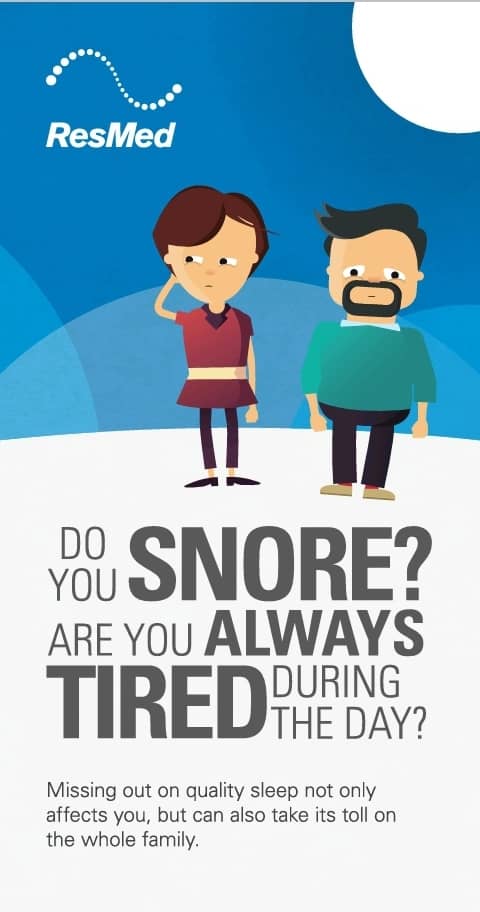Introduction
Sleep apnea is a condition that occurs when a person regularly stop breathing during sleep. Each episodes of stop breathing may take 10 seconds or longer. It can be classified as mild, moderate, or severe, based on the number of apnea and slowed breathing (hypopnea) per hour. Apnea episodes may occur from 5 to 50 times an hour. There are three types of sleep apnoea :
- Obstructive sleep apnea
- Central sleep apnea
- Mixed sleep apnea
This topic focuses on obstructive sleep apnea. In the age group of 30 years & older, the disorder is about three times more common in men than women.
Degrees of severity
The severity of sleep apnoea depends on how often the breathing is interrupted. The following averages can be used as a guide :
- Normal – less than five interruptions an hour.
- Mild sleep apnoea – between 5 to 15 interruptions an hour.
- Moderate sleep apnoea – between 15 to 30 interruptions an hour.
- Severe sleep apnoea – over 30 interruptions an hour.
This can be determined by a Sleep Study (Polysomnography). The test is available in both Private and Public Medical Centre.
Causes
Obstructive sleep apnea (OSA) usually is caused by a :
- Obesity (most common ), short and large neck or collar size, small chin
- Blockage (obstruction) in the nose, mouth, or throat (airway) from a structural problem, such as an enlarged tongue or tonsils.
Other contributing factors :
- Alcohol, especially in the evening, which relaxes the throat muscles and hampers the brain’s reaction to sleep disordered breathing.
- Certain illnesses, like abnormal thyroid hormone or the presence of a very large goitre.
- Medications, such as sleeping tablets and sedatives.
- Smoking.
How it happened?
Partially blocked breathing airway does not cause problem during the day when the person in upright position. However, during sleep , fatty tissue in the neck can press down the airway, narrowing it and causing Obstructive Sleep Apnoea. This condition make worst by alcohol or medications that cause relaxation of throat muscle and subsequently collapse during sleep.
While sleeping, the muscles of the throat relax to the point of blocking the airway above the voice box. Breathing stops, for between a few seconds and up to one minute, until the brain registers the lack of breathing (or a drop in oxygen levels) and sends a small wake-up call. The sleeper rouses slightly, typically snorts and gasps, then drifts back to sleep almost immediately. In most cases, the person suffering from sleep apnoea doesn’t even realise they are waking up. This pattern can repeat itself hundreds of times over every night, leaving the person dogged by sleepiness and fatigue.
Signs and symptoms
The main symptoms of sleep apnea are loud snoring frequent wake up during sleep and sleepiness during the day. Your bed partner may notice periods when you stop breathing during sleep. Generally, People with sleep apnea have snoring but not all snorers have sleep apnea. Some of the associated symptoms include :
- Tossing and turning during sleep.
- Feeling suffocated during sleep.
- Day time sleepiness, fatigue and tiredness.
- Poor concentration.
- Irritability and mood changes.
- Impotence and reduced sex drive is sometimes reported.
- Morning headaches.
- Feeling irritated and unrested.
- Falling asleep at inappropriate times, such as while eating, driving, or talking.
- Problems on the job.
Complication
People with significant sleep apnoea have an increased risk of :
- Motor vehicle accident
- Hypertension
- Heart Attack
- Stroke
Treatment
Mild OSA change in life style including losing weight, developing good sleep habits/sleep hyugiene, and avoiding alcohol, smoking and certain medications may cure the condition.
Any contributing medical condition, such as low production of thyroid hormone, needs to be treated.
Sleep apnea is usually worse when supine, some may benefits from relatively simple measures such as sewing a tennis ball into the back of a T-shirt to promote sleeping on the side.
Moderate to severe OSA, may need to use a breathing device (CPAP/BPAP; a continuous or biphasic positive pressure) that prevents airway from closing during sleep. If it is not effective, or if enlarged tissues or other mechanical onbstruction are causing the blockage, surgery may be needed.
Mouthguard which can prevent the tongue from falling back and causing obstruction during sleep by holding the jaw in a forced forward position.This treatment is made available by Orthodontist.
Surgery addressing the obstruction either in the nose or throat.
Prevention
Obstructive sleep apnea and snoring can be prevented by :
- Avoiding the use of alcohol and medications, such as sleeping pills and tranquilizers, that slow your breathing.
- Eating sensibly, exercising, and maintaining a weight as close as possible to a healthy body weight. (normal BMI)
- Sleeping on your side. Sleeping on your back can increase snoring. Try sewing a pocket in the middle of the back of your pajama top, putting a tennis ball into the pocket, and stitching it closed. This will help keep you from sleeping on your back. Sleeping on your side may eliminate mild sleep apnea.
- Quitting smoking, which may decrease your risk of developing sleep apnea.
- Raising the head of your bed 4 in. (10 cm) to 6 in. (15 cm) by putting bricks under the legs of the bed (using pillows to raise your head and upper body will not work).
- Promptly treating breathing problems, such as a stuffy nose caused by a cold or allergies. Breathing problems can increase the risk of snoring. Avoid taking antihistamin because they can cause drowsiness and worsen apnea episodes. Instead, use decongestants, and non sedating antihistamine which increase drainage.
- Practise good sleep hygiene


